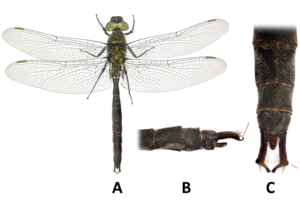Polar emerald dragonfly
| Polar emerald dragonfly | ||||||||||||
|---|---|---|---|---|---|---|---|---|---|---|---|---|

Polar emerald dragonfly ( Somatochlora sahlbergi ) |
||||||||||||
| Systematics | ||||||||||||
|
||||||||||||
| Scientific name | ||||||||||||
| Somatochlora sahlbergi | ||||||||||||
| Trybom , 1889 |
The polar emerald dragonfly ( Somatochlora sahlbergi Trybom , 1889) is a dragonfly named after the Finnish-Swedish scientist Carl Reinhold Sahlberg (1779–1860) from the family of falcon dragonflies (Corduliidae).
features
The body length of the polar emerald dragonfly is 48 to 50 millimeters, of which 32 to 35 millimeters are on the abdomen . The wingspan is between 65 and 70 millimeters. In the resting position, they are carried protruding sideways from the body.
Both the male and female polar emerald dragonflies have an almost uniform, light bronze-green color. As with all falcon dragonflies, this one has relatively large compound eyes (oculi compositi) and a prominent protruding forehead (frons). On both sides of the upper jaw (mandibula), a yellow mark can be clearly seen below the antennae. The males differ from other falcon dragonflies by the strong upper abdominal appendages (cercus), which are almost at right angles at the back and are densely provided with soft bristles. An anal cubital vein runs in each of the forewings of the females. Since other species of this genus each have two of these veins, the polar emerald dragonfly can be clearly distinguished from them. The yellow basal spots on the wings are missing in the female. The genital plate is relatively small, and the third abdominal segment is severely narrowed in the females.
Reproduction
The eggs are deposited close to the bank in the shallow water on the bottom, where the hatched larva also develops over several years. When the larvae reach the last molt before the imago stage , they climb on plants or the like to the surface of the water. The dragonfly hatches above the surface of the water and remains until the exoskeleton has hardened and the wings are fully developed.
Counts have shown that most of the larvae are found at the Nordic tree line. Your head is strongly constricted from the rest of the body, the eyes are comparatively large. The antennae are darkly circled, especially in the last larval stages. The adults usually do not stray far from the development area.
Occurrence
The distribution area of the polar emerald dragonfly extends mainly over the entire north of Russia , but is also found in northern Europe , Alaska and Canada . The flight time lasts from June to October at the most, but mainly only from July to August. It inhabits medium-sized lakes surrounded by peat moss , sedge and thickets of similar plants, oxbow lakes of rivers, ponds and moors.
etymology
The taxonomic epithet of the polar emerald dragonfly was named sahlbergi after the Finnish entomologist and botanist Carl Reinhold Sahlberg . He is considered to be one of the scientific founders of Finnish biology .
literature
- Hans Olsvik: Distribution, habitat and conservation status of threatened Odonata in Norway . In: Fauna Norvegica . Ser. B, vol. 39. Oslo 1992, p. 1-21 .
- Göran Sahlén: Sveriges Trollsländor . Stockholm 1996, ISBN 91-85094-43-9 .
- VE Skvortsov: Стрекозы Восточной Европы и Кавказа = The dragonflies of Eastern Europe and Caucasus . KMK, Moscow 2010, ISBN 978-5-87317-657-1 , pp. 382-404 .
- AG Tatarinov, OI Kulakova: Фауна европейского Северо-Востока России = fauna of the European northeastern Russia. Vol. 10: Strekozy = dragonflies . St. Petersburg 2009, ISBN 978-5-02-026352-9 , pp. 135-147 .